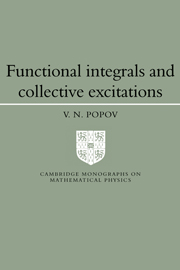Book contents
- Frontmatter
- Contents
- Preface
- Part I Functional integrals and diagram techniques in statistical physics
- Part II Superfluid Bose systems
- 5 Superfluidity
- 6 Low-density Bose gas
- 7 The modified perturbation scheme for superfluid Bose systems
- 8 Quantum vortices in superfluids
- Part III Plasma and superfluid Fermi systems
- Part IV Crystals, heavy atoms, model Hamiltonians
- References
- Suggested further reading
- Index
8 - Quantum vortices in superfluids
Published online by Cambridge University Press: 01 June 2011
- Frontmatter
- Contents
- Preface
- Part I Functional integrals and diagram techniques in statistical physics
- Part II Superfluid Bose systems
- 5 Superfluidity
- 6 Low-density Bose gas
- 7 The modified perturbation scheme for superfluid Bose systems
- 8 Quantum vortices in superfluids
- Part III Plasma and superfluid Fermi systems
- Part IV Crystals, heavy atoms, model Hamiltonians
- References
- Suggested further reading
- Index
Summary
In addition to the acoustic (phonon) excitations described above, specific excitations called ‘quantum vortices’ may exist in superfluid Bose systems.
Attempts to incorporate the vortex excitations have already been made in the original version of Landau's theory (Landau, 1941). The existence of a periodical lattice of quantum vortices in a superconductor located in a magnetic field was conjectured by Abrikosov (1952, 1957). The idea of quantum vortices occurring in rotating helium below the λ-point was introduced independently by Onsager (1949) and Feynman (1955).
In this section we present the description of quantum vortices in the functional integral formalism. We will also discuss the role of quantum vortices in the phase transition for the superfluid to the normal state.
Our starting point is the functional integration scheme over fast and slow variables. We will apply this formalism mainly to two-dimensional Bose systems and will try to take into account vortex-like configurations of the Bose field. We thus come to the conclusion that the system of vortices is equivalent to the system of charged particles interacting via a new field which play the role of electromagnetic field. At small temperatures there are only pairs with opposite signs, bounded by the long-range logarithm potential. It turns out that the phase transition in the two-dimensional Bose system is nothing but the dissociation of bounded pairs. A similar approach to the three-dimensional systems leads to the conclusion that phase transition is accompanied here by creation of long vortex filaments.
- Type
- Chapter
- Information
- Functional Integrals and Collective Excitations , pp. 49 - 56Publisher: Cambridge University PressPrint publication year: 1988



